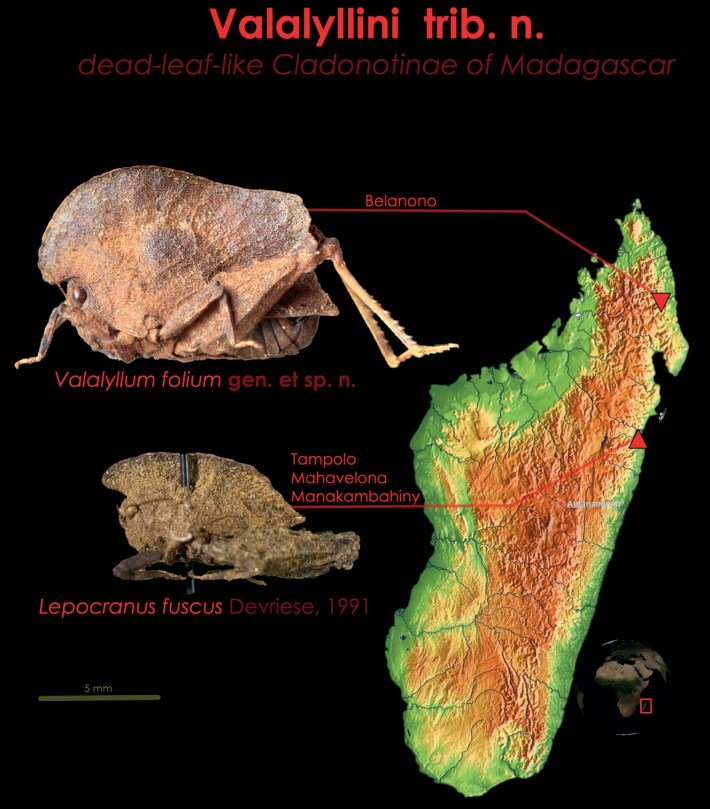To protect their small and smushable bodies from a world that dwarves them, insects have evolved a repertoire of defenses to ward off predators. Some insects will feign death, a strategy called thanatosis. A weevil playing dead will tuck its legs under its body, roll on to its back, and wait in stillness until the predator moves on to more wriggly pastures. Other insects have evolved to camouflage themselves as leaves. Leaf insects in the family Phylliidae can be nearly indistinguishable from a broad green leaf swaying from a branch.
Some insects even resemble dead leaves, and they are so good at resembling dead leaves that they can be nearly impossible to spot in the leaf litter blanketing a forest floor. Several species of pygmy grasshoppers in the family Tetrigidae resemble leaves. These insects' mastery of mimicry makes life difficult for the scientists studying them, who may have never actually seen the insects alive or in the wild, in part because they are very difficult to find.
"Unfortunately, a very large percentage of the described species of Tetrigidae have never been seen in nature after the original museum specimens were collected," Niko Kasalo, a masters student at the evolution lab at the University of Zagreb, wrote in an email. "That does not mean they are extinct, just that they are hard to spot and often live in inaccessible areas."
In Madagascar, a country with dizzying biodiversity that is also home to a very convincingly leaf-like reptile called the satanic leaf-tailed gecko, scientists had described just one species of leaf-like pygmy grasshopper, Lepocranus fuscus, or the leatherback pygmy grasshopper. Now, a group of scientists including Kasalo have described a new species of leaf-like pygmy grasshopper, Valalyllum folium, which they call the Malagasy litterhopper, in the journal ZooKeys. They say the new species, also represents a new genus.

The Malagasy litterhopper is about the size of an M&M and looks remarkably like a dead leaf, with many fine veins running along its thorax and a uniform brown color with yellowish legs. The description was based on a single specimen collected years ago in northern Madagascar, which is now housed in the French National Museum of Natural History—one of many museums in Europe that amassed significant collections under colonial rule.
Kasalo and his co-authors compared the museum's specimen of the Malagasy litterhopper to a specimen of the leatherback pygmy grasshopper, which was rather old and partially destroyed by mold (a deterioration that has unfortunately rendered the specimen considerably less leaf-like). "Clearly, this situation is not ideal," the authors wrote in the paper in reference to the mold. But "it was immediately clear that the new one is different," Kasalo said.
None of the authors have ever seen the Malagasy litterhopper alive (or dead) in the wild, but they suspect the litterhopper inhabits a very small geographic region. Madagascar's rainforests, like many of the world's tropical forests, face ongoing deforestation and other human-caused threats. The authors recommend the litterhopper be listed as endangered under the IUCN Red List, which tracks the extinction risk of animals, fungi, and plants around the world. The litterhopper cannot easily relocate, being so small and leafy. "They don't have wings so it's hard for them to disperse," Kasalo said.
Deforestation in Madagascar has colonial roots; the first 30 years of French rule destroyed almost three-quarters of the country's remaining primary rainforest, wrote the geographer Christian Kull in the journal International Environmental Affairs in 1996. When the French colonial government did introduce protected areas in 1927, these areas offered no economic benefits to local communities, who viewed these areas as another arm of colonial oppression, Kull wrote in the journal African Studies Quarterly in 1999.
Kasalo suggested the northern Madagascar forests that are home to the new leafy litterhopper likely contain many other species that have yet to be described by scientists. Of course, some of these species may already be known to local communities. But the Malagasy litterhopper may have other relatives trundling around Madagascar's leaf litter which teems with dead leaves that are actually living insects, dead leaves that are actually dead insects, and dead leaves that are actually dead leaves.






